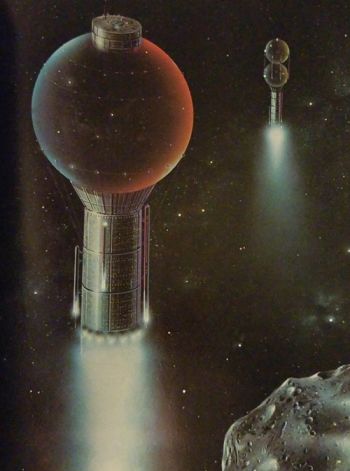Difference between revisions of "Galileo class (FASA)"
m |
|||
| Line 1: | Line 1: | ||
{{DISPLAYTITLE:''Galileo'' class}} | {{DISPLAYTITLE:''Galileo'' class}} | ||
[[File:galileo_class-sfc.jpg|350px|thumb|right|''Galileo'' class ([[Star Trek: Spaceflight Chronology|SFC]])]] | [[File:galileo_class-sfc.jpg|350px|thumb|right|''Galileo'' class ([[Star Trek: Spaceflight Chronology|SFC]])]] | ||
| − | The ''Galileo'' class entered service in [[Chronology: | + | The ''Galileo'' class entered service in [[Chronology: 2030s#2036|2036]]. One of the most durable workhorses in spaceflight history, ''Galileo'' class ships were early fusion ships that could attain modest relativistic speeds (.2[[speed of light|c]]; later .35c) and began to take [[Humans|humanity]] into interstellar space. In the [[Chronology: 2040s|2040s]], the ''Galileo'' class was the primary ship class to the asteroid belt, and in the [[Chronology: 2050s|2050s]], it was the most popular carrier to the outer planets. The ''Galileo'' class vessels were retired from service in [[Chronology: 2060s#2060|2060]]. The ''Galileo'' class featured a complement of 98 personnel, including six officers and 92 enlisted crew members, and could be modified with multiple forward fuel spheres for extended missions. The ''Galileo'' class was the first Human vessel equipped with elementary interstellar celestial navigation.<ref name="SFC"/> |
===''Galileo'' class vessels=== | ===''Galileo'' class vessels=== | ||
Revision as of 05:20, 7 May 2019

The Galileo class entered service in 2036. One of the most durable workhorses in spaceflight history, Galileo class ships were early fusion ships that could attain modest relativistic speeds (.2c; later .35c) and began to take humanity into interstellar space. In the 2040s, the Galileo class was the primary ship class to the asteroid belt, and in the 2050s, it was the most popular carrier to the outer planets. The Galileo class vessels were retired from service in 2060. The Galileo class featured a complement of 98 personnel, including six officers and 92 enlisted crew members, and could be modified with multiple forward fuel spheres for extended missions. The Galileo class was the first Human vessel equipped with elementary interstellar celestial navigation.[1]
Galileo class vessels
Specifications
| Length | 300m |
| Diameter | 120.7m |
| Mass | |
| Fuel Sphere | main: 920,000 m³ |
| Crew Compartment | |
| Cargo Volume | 40,000 m³ |
| Forward Command Sensor Disc Diameter | 35.5 m |
| Propulsion | 24 Space Op Fusion Engines with 10 laser/electron fusion initiators per engine |
| Fuel | Frozen deuterium |
| Navigation | Interplanetary Triangulation/Elementary Celestial Navigation |
| Communications |
|
| Computer | Intermediate Independent Thought Memory Scan |
| Life Support | |
| Range | 12 years at standard ship's complement of 6 |
Performance
| Range (Standard) | 800 million km (Earth to asteroid belt) |
| Range (Maximum) | 1013 km (~1 light year) |
| Cruising Velocity | 200 million km/hr |
| Maximum Velocity | 375 million km/hr |
| Typical Voyage Duration | 17.4 hr (asteroid belt) 45 hr (Pluto Research Station) |
| Maximum Voyage Duration | 2.3 years |
| Acceleration | |
| Thrust | 10 million kg per fusion engine |
FASA Timeline

The Galileo class entered service in 2028. One of the most durable workhorses in spaceflight history, Galileo class ships were early fusion ships that could attain modest relativistic speeds (.2c; later .35c) and began to take humanity into interstellar space. In the 2030s, the Galileo class was the primary ship class to the asteroid belt, and in the 2040s, it was the most popular carrier to the outer planets. The Galileo class vessels were retired from service in 2052. The Galileo class featured a complement of 98 personnel, including six officers and 92 enlisted crew members, and could be modified with multiple forward fuel spheres for extended missions. The Galileo class was the first Human vessel equipped with elementary interstellar celestial navigation.[1]
Galileo class vessels
Specifications
| Length | 300m |
| Diameter | 120.7m |
| Mass | |
| Fuel Sphere | main: 920,000 m³ |
| Crew Compartment | |
| Cargo Volume | 40,000 m³ |
| Forward Command Sensor Disc Diameter | 35.5 m |
| Propulsion | 24 Space Op Fusion Engines with 10 laser/electron fusion initiators per engine |
| Fuel | Frozen deuterium |
| Navigation | Interplanetary Triangulation/Elementary Celestial Navigation |
| Communications |
|
| Computer | Intermediate Independent Thought Memory Scan |
| Life Support | |
| Range | 12 years at standard ship's complement of 6 |
Performance
| Range (Standard) | 800 million km (Earth to asteroid belt) |
| Range (Maximum) | 1013 km (~1 light year) |
| Cruising Velocity | 200 million km/hr |
| Maximum Velocity | 375 million km/hr |
| Typical Voyage Duration | 17.4 hr (asteroid belt) 45 hr (Pluto Research Station) |
| Maximum Voyage Duration | 2.3 years |
| Acceleration | |
| Thrust | 10 million kg per fusion engine |
References
- ↑ 1.0 1.1 Goldstein, Stan and Goldstein, Fred with Sternbach, Rick. Star Trek: Spaceflight Chronology. Pocket Books, 1980.